The Importance of Contemporary Poetry

One of the questions asked that stood out to me was about the importance of this style of contemporary poetry, especially so-called Insta-poetry, and why it is connecting with so many readers. This line of questioning seemed incredibly relevant, especially as the National Endowment for the Arts has noted, poetry is more popular than ever.
The consensus seemed to be that this style of poetry connects with readers because it’s simple and accessible while expressing truths so many face. Thomas said that in his experience, many people like his poems because he says something that they feel but didn’t have the language to express themselves.
To me, the poets’ answers to these questions were spot on. I studied English in university and that, of course, involved some poetry. While there were many poems that I loved, I had to study them to connect with them. The structure in themselves was an art, but it wasn’t often an art that I found a personal connection with.
Until about a year ago, I wouldn’t have really considered myself a poetry reader. I had a few lingering favourites from university—Emily Dickinson, Christina Rossetti, Sylvia Plath—but none that I really actively, truly loved.
Then Rupi Kaur came into my life. This best-selling, award-winning, Instagram-posting international sensation piqued my interest. And when I picked up milk & honey I got it. I was completely entranced. While more stylistically complex poetry has its place, milk & honey made me cry but then also dry my tears. The Princess Saves Herself in this One gave me the courage to stand up under the crushing weight of my insecurities. Wild Embers reminded me of my own importance.
There have always been different kinds of poetry out there, but that this accessible sort has broken into the mainstream is really valuable. Poetry is no longer niche. As the NEA research says, for young people, poetry readership has doubled. For women, African Americans, Asian Americans, and other non-white, non-hispanic groups poetry readership has gone up substantially. The poets on this panel were all best-selling authors.
Through poetry, life and my reading life have certainly become richer. I’m excited to find new poets I love and other readers who love them. What about you?
Want more poetry in your life? Check out these 18 Powerful Poetry Books Like Milk and Honey, this Beginner’s Guide to Confessional Poetry, and 14 of Our Favourite Instagram Poets!














